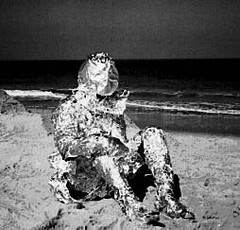Kroeger, Brooke. Passing, When People Can’t Be Who They Are. Cambridge: Perseus Books Group, 2003.Through six detailed biographies
Brooke Kroeger examines “passing” as a common phenomenon in our contemporary culture. Though the typical conception of passing is that of black posing as white, the author looks at passing accomplished for many reasons including combinations of religious, ethnic, racial, and sexuality. Referring to both the 1934 and 1959 film versions of
Fanny Hurst’s “Imitation of Life” the author states the following. “Despite the different plots, the moral in each version of the story is the same. Passing, if not altogether bad, is at least a really bad idea, and society, or life itself, will punish the “passer” for breaking the rules. A “Peola,” a passer, in fiction or in real life, has never been a good thing to be. “(Brooke, 2) Of course, the author is talking of black passing as white whereas I am most concerned with gay passing as straight, not quite the same thing, but similar enough to draw many parallels between the two. For instance, Ms. Kroeger goes on to say that the actual culprit in both versions of the story is racism, not passing, and it’s fair to say that the real culprit in gays passing as straight is intolerance (heterosexism), not passing.
“The prevalence of passing today really shouldn’t have surprised me. As scholars tell us, wherever there is prejudice and preconception, there is passing, and of prejudice and preconception we as yet have no lack.”(Brooke, 4)
So what harm is there in passing? Kroeger’s intention, at least in part, is to challenge the negative views the general culture has of passing through biographical research into the lives of six contemporary persons who have passed. She includes commentary from psychologists and other experts, and juxtaposes these with actual tragic passing sagas such as the motion picture "
Boys Don’t Cry" the story of the murder of Brandon Tina.
The LGBT community as a sub culture also maintains the negative view held by the larger culture, the belief that a LGBT (lesbian, gay, bisexual, transgendered) person will lose his/her self-respect, that he/she will have low self-esteem, and that other maladjustments will be manifest. It is also the general belief within the gay community that “coming out” is the only remedy to the alternative passing life style of dysfunction, though many (perhaps millions) in small town and rural America still find it necessary to protect themselves from family and a religious culture that will turn on them if they should drop the pretense.
Kroeger describes passing as “performance,” a description that might be applied to all as we place our personality before others (by way of
Judith Butler) in that we “perform” those parts of ourselves that we know will be best received whether by those around us, and/or the critical self within.
In her biography of David Matthews a young man who passes as white and Jewish, Kroeger proffers “the whys and wherefores of being someone with an ambiguous personal presence, one that offers the right to float and a shore pass for both sides of the gully between the black identity he has no choice about and the white and Jewish identities he can so ably “perform.”(Brooke, 16)
Again we can draw some obvious parallels between passing (in this case double passing) for color / Jewish ethnicity and homosexual passing for heterosexual, as the homosexual most often has no choice about his/her sexuality (despite evangelical Christian dogmatism), but can perform as a heterosexual in public and the work place. However, a major difference exists between passing for another race versus passing straight for gay. That difference being that our families make assumptions concerning our identity – that we are, like them, black, or white, Christian, Muslim, Jewish, but always we are believed to be, and taught to perform as heterosexual. Those who cannot perform the part are labeled, queer, dyke, butch, fem, bitch, dolly, pansy, and so on. They are ostracized and risk emotional and physical harassment at home and school. Thus, the gay person feels he/she must cover his/her sexuality and pass for “straight.” If the performance is successful, he/she is given all the perks his family, society and culture normally bestow. The youth is taught that passing is necessary. He/she is encouraged in the disguise whereas a charade to disguise race is under most circumstances extremely difficult if not ludicrous for all who pass the passer “know” despite the mannerisms, accent, body language, and other learned characteristics the poser manifests.
I have found Kroeger’s book to be informative and intriguing, if a bit frightening - Frightening because I am convinced that in all but the major cities, and/or in many careers it may be just as necessary to pass as in the past. The book demonstrates the fluidity of identity, and I fear that many - as I was for most of my adult life - live a performed reality, an actor on a stage, isolated from much of objective reality, as well as their own innermost persons.
You can send E-mail comments to ZacSfuts@Comcast.net
, or post them below.








